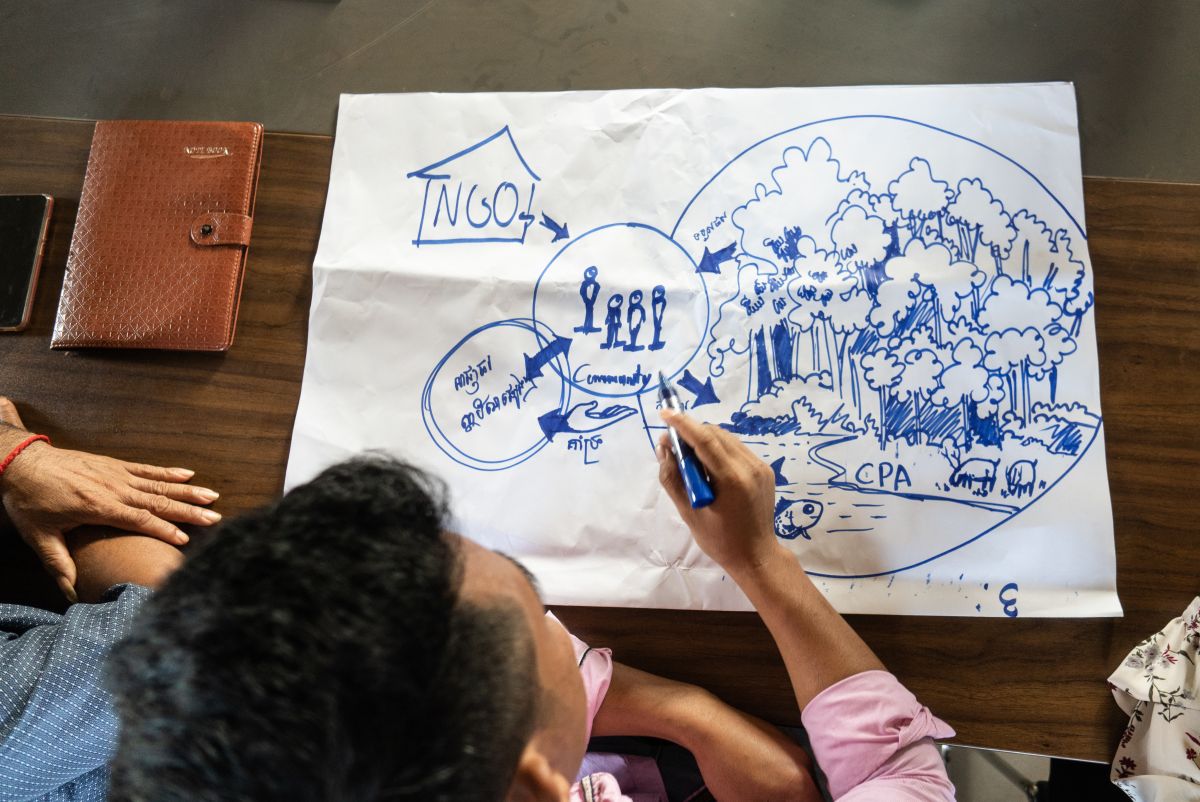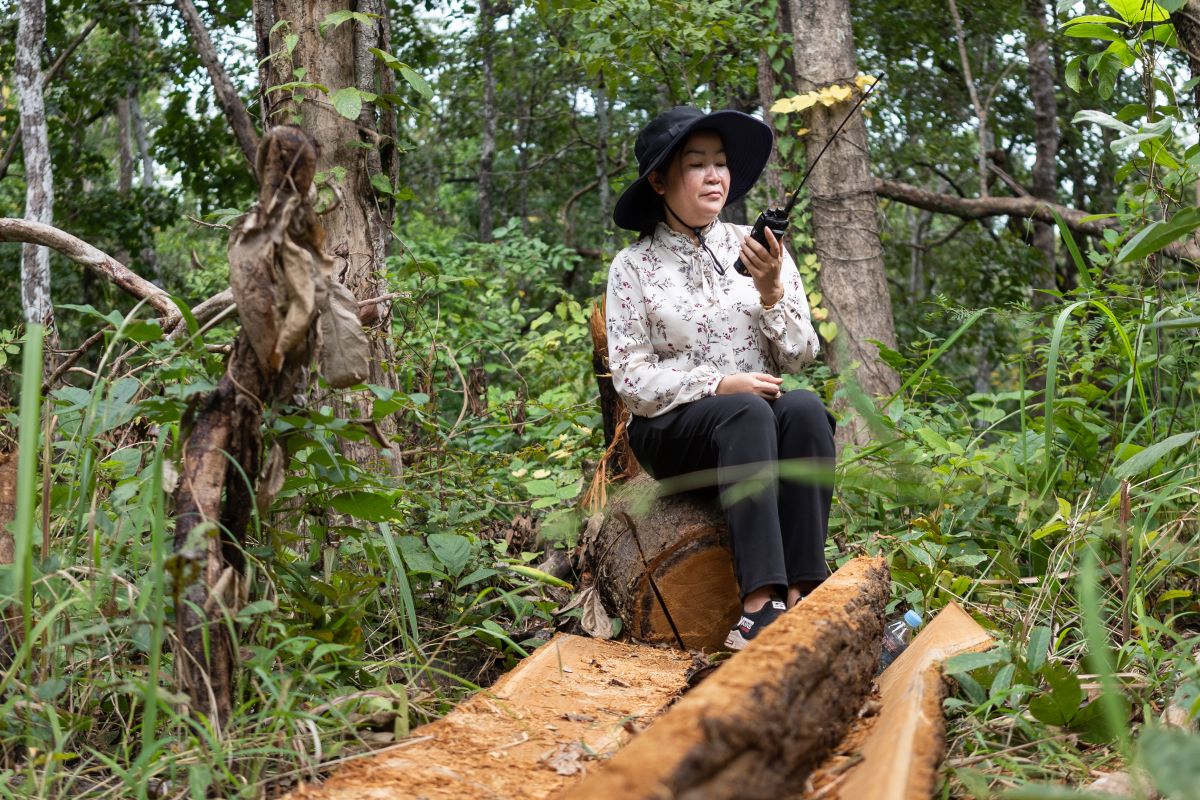

In 2010, just as some officials in the Ministry of Agriculture, Forestry and Fisheries were leasing land near Prey Lang Forest to a Vietnamese rubber company, other officials in the Ministry were busy promoting community forestry within national policies.
Among them was Long Ratanakoma, now Deputy Director of the Department of Forest and Community Forestry. In 2006, he joined a group developing the National Community Forestry Program. As the program grew, Long noticed that other officials within the Ministry and the Forestry Administration were developing a better understanding of the potential role of community forestry in the forestry sector.
“If communities don’t benefit from their forests, then they have less incentive to protect them and fewer resources with which to fund protection.” — Long Ratanakoma
In 2010, Long was proven correct. The program he was working on was subsumed into the country’s new National Forest Program. Community forestry now formed one of six pillars in the new strategy for the development of the forestry sector. The National Forest Program reinforced efforts to formalize community forests by mandating the identification and formalization of community forestry groups. Importantly, it also mandated the Government to support community forestry institutions as a means for developing livelihoods.
For Long, this signalled a shift in the Government’s approach. Earlier legal tools had “legalized” community lands. But the National Forest Program now sought to move beyond this and provide opportunities for communities to protect and also benefit from forest land.
“If communities don’t benefit from their forests, then they have less incentive to protect them and fewer resources with which to fund protection,” says Long. “In essence, the whole purpose of community forestry crumbles.”

The 2010 National Forest Program set a goal of 2 million hectares of community forests by 2029. This was the area left after goals had been set for other types of forests, including protection and production forests.
Community forestry was allocated less than one-fifth of the total forest area but its position as one of six pillars of the new strategy meant community forestry practitioners had a foot in the door. RECOFTC established its country office that same year, in 2010, and would use this position moving forward.
Taking the next step
In line with the new strategy, the Government and non-government organizations began to work with communities on making formalized community forests economically and ecologically productive. This was a challenge because the forest land allocated to them was highly degraded.
As per the 2006 prakas, a community had to develop a community forest management plan and wait for five years after the approval of their management plans before it could legally harvest non-timber forest products for commercial use. The management plan outlines how a community will sustainably manage its resources over its 15-year lease period. In 2010, there was little understanding of how to develop such a management plan.
RECOFTC had tried to do this through projects in 2009, but guidelines from the Government were too technical. Consequently, the process to develop, prepare and submit a comprehensive management plan to the local forestry administration was time-consuming and difficult.
To overcome this, RECOFTC designed and piloted a systematic approach to creating management plans together with Oxfam Great Britain, the Forestry Administration and local authorities. The governments of Denmark, Spain and the European Union funded the initiative. In one year, the partners developed a national community forest management plan manual. RECOFTC and other agencies then tested and adapted the manual, in line with the realities.
Integrating with commune development plans
In 2012, a year after the launch of the manual, RECOFTC joined the United Nations Development Program’s (UNDP) Capacity Development for Sustainable Forest Management Project. Project partners worked to minimize deforestation and alleviate poverty in the western Cardamom Mountains landscape.
The Cardamom Mountains is a patchwork of officially designated protected areas. But despite national laws that prohibit logging in such areas, it suffered widespread deforestation and degradation from 2002 to 2014 due to the systematic granting of concessions. In 2011, for example, the Government leased out 751,882 hectares across the country as economic land concessions. Journalist Sebastian Strangio reported that approximately two-thirds of this land was “in protected areas since most of the country’s agricultural land was already taken”.
The UNDP project envisaged a role for community-led forest management. RECOFTC replicated its “vertical approach” to provide training on community forestry management planning to officials at the local, provincial and national levels. RECOFTC and partners also piloted new funding models to ensure that community forests were properly endowed.
“We moved beyond just making plans and establishing community forests,” says Nhem Sovanna, who coordinated the UNDP project in 2012. “We were trying to figure out how to sustain community forestry.”
Nhem had worked with UNDP on the decentralization process in Cambodia since 1997. He knew from this experience that the most localized level of government, the commune council, was an important source of funding for community-based natural resource management. He thought, for example, that the commune land-use plans could increase funding for community forests. Commune councils allocate funds to specific projects through these plans.
If a community could integrate its community forest management plan with the commune development plan, then community forests and other models of natural resource management would be situated within the overarching development of the area.
It worked.
By 2014, just two communities across Cambodia had confirmed their management plans with the Forestry Administration. By 2016, this number had risen to 73. Thirty of those were established through the project in the Cardamom Mountains.
Applying old lessons to new models
The Capacity Development for Sustainable Forest Management Project worked with many communities whose land was under the jurisdiction of the Ministry of Environment. Their model for including communities in the management of protected areas emerged alongside community forestry in the 1990s.
When the Sub-Decree #79 on Community Forestry Management was passed in 2003, the Ministry issued a proclamation to encourage community organizations to manage forests in the previously established protected areas. But the proclamation was not followed with the same level of laws, guidelines or support that accompanied community forests.
It wasn’t until 2008, when Cambodia passed the Protected Areas Law, that communities were able to claim legal title to their land and lawfully use the forest in similar ways as community forests. The law established four zones within protected areas: the core zone, conservation zone, sustainable-use zone and the community development zone. An “official” new model was termed: community-protected areas.

By 2014 the model was lagging. In that year, RECOFTC and partners in the project began to put their experience in community forestry into practice with community-protected areas.
Oum Koeurn, who worked for the Ministry of Environment in Pursat Province, notes that after this, there was more technical support for communities living in and near protected areas. The work RECOFTC and other partners completed in the Cardamom Mountains was instrumental in updating how to develop and establish community-protected areas in the area. According to Oun, the work created a better understanding of the importance of community-based models.
It was important that communities, local authorities and ministry officials were starting to better understand the importance and technicalities of community-led forestry, given the political situation in 2016. That year, the Government started to transfer lands from the Ministry of Agriculture, Forestry and Fisheries under the jurisdiction of the Ministry of Environment. Communities that had previously formalized their land as community forest now had to transfer their formalization to meet the criteria of community-protected areas. But there were no guidelines on how to do this. Even the guidelines for developing a community-protected area would not be ready until a year later.
Kim Sarin and others close to the work that RECOFTC did from 2012 to 2015 found that the experiences in the Cardamom Mountains and throughout the country were consolidated to generate the guidelines. Practice had translated into policy.
The mainstream?
By 2017, community-led forestry models had much progress in both the discourse and practice of development agencies and the Government. The laws and guidelines were in place, funding mechanisms were being tested, and communities were more aware of their rights and how to exercise them.
This evidence indicates that although the country’s forests were declining during this period, the health of community forests and community-protected areas remained steady or improved. Remote sensing data from 2012 to 2015 revealed that community forests had higher rates of forest cover and lower rates of forest loss comparatively.
Sou Sunthary, a committee member of Pou Chrey Community-Protected Area in Mondulkiri Province, attributes the slower rates of forest decline to the community’s patrols of their forest. One such patrol, in 2018, found a private company clearing land for stone mining near Srepok Wildlife Sanctuary. Although the company had an official permit, the community was able to stop it from clearing the land.

Despite these signs of success, there are still fewer than 1,000 community forests or community-protected areas. Their total area of approximately 700,000 hectares of forests is just 35 percent of the target to achieve by 2029. Communities with and without formal recognition of their land still face the fundamental problems inherent in the country’s system of forest management—elite capture, degraded land and weak legal implementation.
The 2012 moratorium on granting economic land concessions did little to halt the degradation and deforestation of Cambodia’s land by multinational corporations. In turn, the ecological health of the country has continued to decline. According to the UNDP 2019 Human Development Report for Cambodia, as community forests and community-protected areas began to flourish from 2010 to 2018, forest cover shrank from 57 percent to 47 percent.
The country's forests still experience deforestation and degradation today. Illegal logging persists, as does elite capture at the national and local levels. And community land continues to be encroached upon. For many forest communities, the future remains uncertain. With the transferring of lands between ministries and the second phase of decentralization under way, it is clear that community-based forestry models stand at a crossroads.

